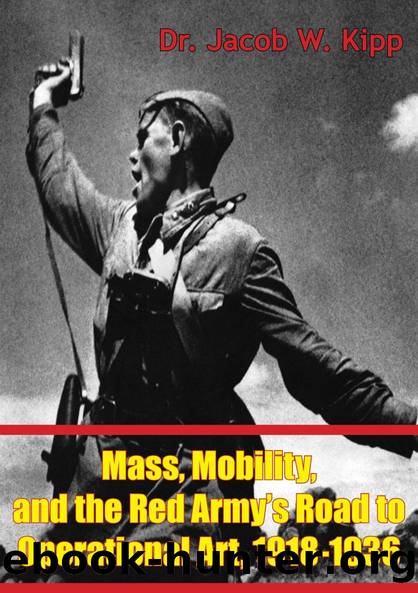Mass, Mobility, And The Red Army's Road To Operational Art, 1918-1936 by Dr. Jacob W. Kipp

Author:Dr. Jacob W. Kipp [Kipp, Jacob W.]
Language: eng
Format: epub
Tags: History, Military, United States, Europe, General, Germany, Asia, Japan
ISBN: 9781786250599
Google: 2iZwCwAAQBAJ
Publisher: Pickle Partners Publishing
Published: 2015-11-06T05:07:38+00:00
THE MECHANIZATION OF DEEP OPERATIONS
There were, however, other advocates of operational art, who argued that technological developments and the nature of the external threat made it absolutely essential to carry out a total mechanization of the Red Army and Soviet rear. One of the leading proponents of such views was M. V. Tukhachevsky, who was Triandafillovâs immediate boss as Chief of the RKKA Staff from 1925 to 1928. Tukhachevsky argued that what was required to make the new operational art into a sound strategic posture was nothing less than âcomplete militarizationâ of the national economy to provide the new instruments of mechanized warfare. Committed to an operational art which would end in the total destruction of the enemy, Tukhachevsky crossed pens with Svechin, whom he accused of being an advocate of attrition.{90} According to G. S. Isserson, one of his closest collaborators in the 1930s, Tukhachevsky came forward with a master plan for the mechanization of the Red Army in December 1927, only to have it turned down by the party leadership under Stalin.{91} Several years later, in 1930 Tukhachevskyâs views won favor, when Stalin broke with Bukharinâs thesis on the stabilization of capitalism and began to associate the Depression with a rising threat of war to the Soviet Union. This threat the Party leadership openly used to justify the brutal processes of industrialization and forced collectivization by now linking them with an improvement in the level of national defense.
During the intervening two years Tukhachevsky had left the RKKA Staff to take over as Commander of Leningrad military district, where he conducted a number of experiments relating to mechanization. These experiments came at a time when motorization versus mechanization emerged in Western Europe as alternative solutions to the problem of integrating the internal combustion engine into the armed forces. The former implied grafting automobile transport on to existing combat arms, while the latter called for the creation of âself-propelled combat meansâ with an emphasis upon armor, especially, tanks, armor cars, and self-propelled artillery. Soviet officers who followed developments in France, England, and the United States noted that all armies were exploring both paths but that, owing to strategic, operational, tactical, political and financial circumstances, the French Army was more sympathetic towards motorization and the British towards mechanization.{92} Tukhachevsky in his comments on the training exercises of the troops of the Leningrad Military District emphasized the need to increase their mobility as a combined-arras force, which could engage in a multi-echeloned offensive. His interest in the development of tank, aviation, and airborne forces during this period marked him as an advocate of mechanization.{93}
At the XVI Party Congress and IX Congress of the Komsomol in 1330-1931 K. E. Voroshilov, the Commissar of War and Stalinâs closest collaborator, spoke out regarding the mechanization of warfare as bringing about a qualitative change in the nature of future wars. But in Voroshilovâs case mechanization would in the future bring about the possibility of a short, bloodless war, carried quickly on to the territory of the attacking enemy.
Download
This site does not store any files on its server. We only index and link to content provided by other sites. Please contact the content providers to delete copyright contents if any and email us, we'll remove relevant links or contents immediately.
| Central Asia | Southeast Asia |
| China | Hong Kong |
| India | Japan |
| Korea | Pakistan |
| Philippines | Russia |
The Sympathizer by Viet Thanh Nguyen(4342)
The Rape of Nanking by Iris Chang(4167)
World without end by Ken Follett(3445)
Ants Among Elephants by Sujatha Gidla(3440)
Blood and Sand by Alex Von Tunzelmann(3165)
Japanese Design by Patricia J. Graham(3138)
The Queen of Nothing by Holly Black(2542)
City of Djinns: a year in Delhi by William Dalrymple(2531)
Foreign Devils on the Silk Road: The Search for the Lost Treasures of Central Asia by Peter Hopkirk(2442)
India's Ancient Past by R.S. Sharma(2432)
Inglorious Empire by Shashi Tharoor(2412)
Tokyo by Rob Goss(2405)
In Order to Live: A North Korean Girl's Journey to Freedom by Yeonmi Park(2359)
Tokyo Geek's Guide: Manga, Anime, Gaming, Cosplay, Toys, Idols & More - The Ultimate Guide to Japan's Otaku Culture by Simone Gianni(2345)
India's biggest cover-up by Dhar Anuj(2335)
The Great Game: On Secret Service in High Asia by Peter Hopkirk(2315)
Goodbye Madame Butterfly(2227)
Batik by Rudolf Smend(2151)
Living Silence in Burma by Christina Fink(2048)
